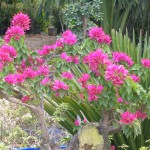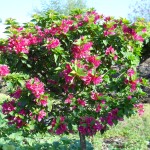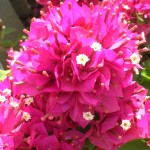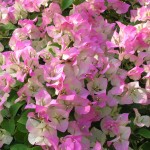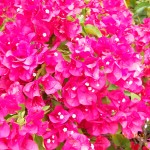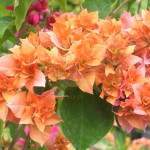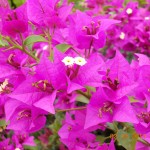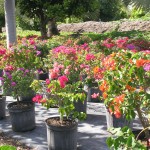Bougainvillea
Did you know that the flowers of Bougainvillea are small and inconspicuous? That’s because the features that produce the spectacular colors found in this genus are actually bracts, modified leaves located at the point from which flowers develop. Thus bracts are an integral part of the flowering process, though they are not flowers themselves.
Did you know that the first woman to circumnavigate the earth was also possibly the first European to discover Bougainvillea? It is reported in some accounts that in 1766 Jeanne Baré (or Baret) was snuck aboard a ship of exploration by her botanist boyfriend, Philibert Commerçon. In order to flout ship rules, she was disguised as a man. We at Richard Lyons’ Nursery try to maintain a high degree of dignity and civility, so we shall not comment further about this aspect of the three-year expedition except to say that advances were made . . . in the name of science.
The spiny woody vine discovered not long after reaching Rio de Janeiro in 1767 was not described botanically until 1789, when it was named for Louis Antoine de Bougainville, the French admiral and explorer who had commanded the voyage. The genus Bougainvillea is native to Peru, Brazil and southern Argentina. There is still some uncertainty about the total number of species; depending on the source consulted, there are somewhere between four and 18. What is certain is that the 1930s ushered in an active period of natural and intentional hybridization, and we are now flush with a whole panoply of bright colors. There are over 300 cultivars (cultivated varieties) of Bougainvillea!
Bougainvillea produces sprawling, arching branches, but can be trained to grow as a standard. Often used in the ground as an impenetrable screening material, it can also be grown in containers or hanging baskets, where pruning following bloom will keep the plant compact and encourage side-branching. And as a container specimen, Bougainvillea is particularly amenable to thriving on high-rise balconies, because it is highly-resistant to winds. Although not extremely cold-hardy, the genus can stand enough frost to be widely grown as an ornamental in southern Switzerland near the foot of the Alps.
The best color production occurs in full sun. The genus is very salt-tolerant, so coastal exposures are no problem. Bougainvillea is also quite drought-tolerant, and once a plant installed in the ground becomes acclimated, it will require little supplemental watering. In fact, the rainy and very hot summers of southern Florida inhibit color displays, so in our region Bougainvillea flourishes best during the dry season. It responds well to light applications of fertilizers, but use of a high-nitrogen formula will produce rampant vegetative growth without much color. A balanced formula is a better bet, and some experts recommend fertilizers formulated for roses or other flowering plants.
The cultivar ‘Pixie’ deserves special mention. Not only is it almost thornless, but it also produces color later into the summer than many other cultivars.
Richard Lyons’ Nursery offers Bougainvillea in shrub form in 3- and 15-gal. containers and as standards in 7- and 15-gal. sizes.
